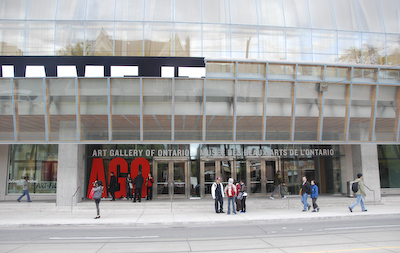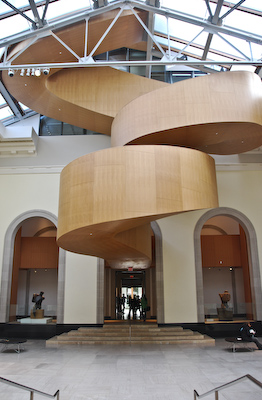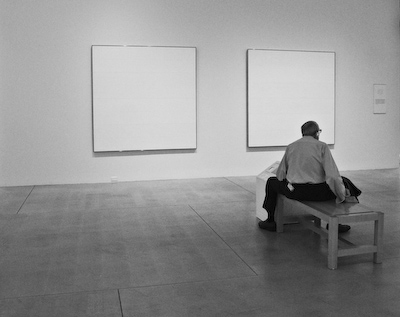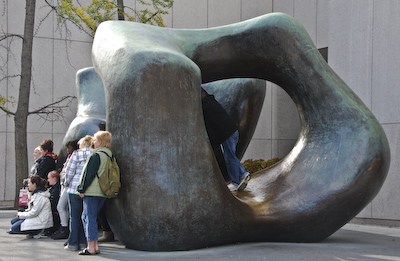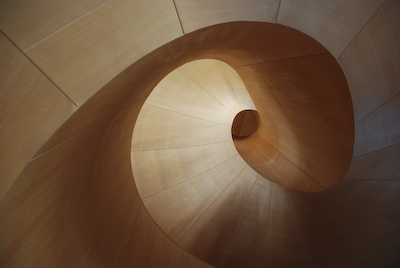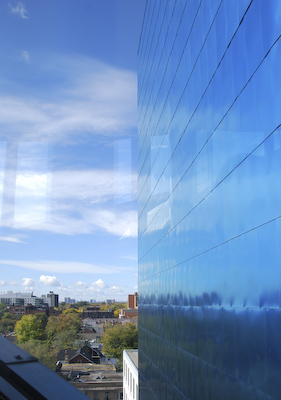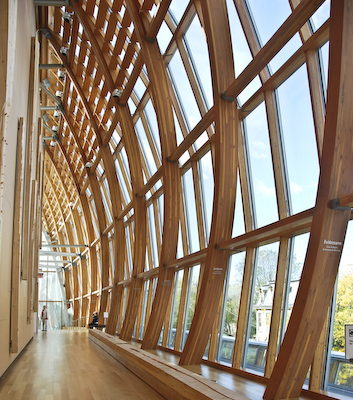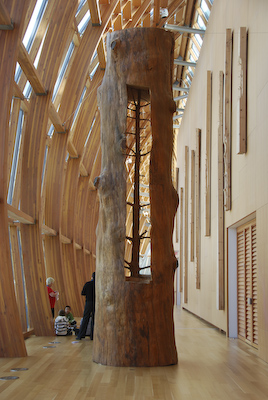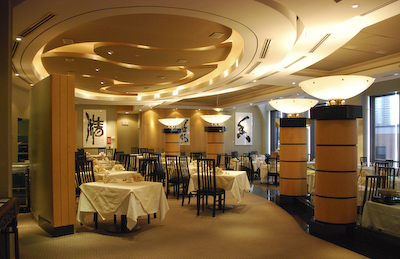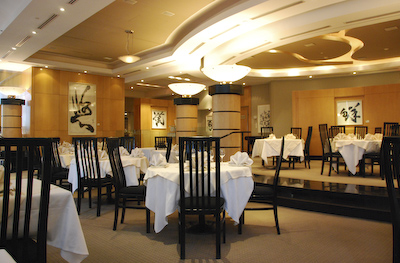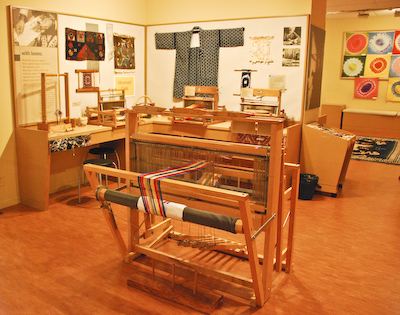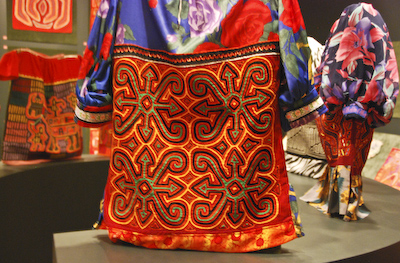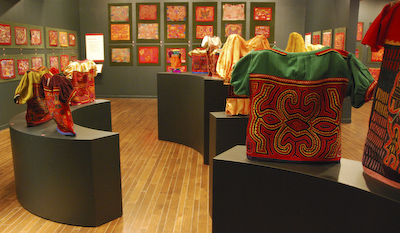Friday – October 15th
The tourist magazine in our hotel stated that Toronto is celebrated as one of the most multi-cultural and multi-ethnic cities in the world. Half if its population was born outside Canada and the city is a gathering place of more than 100 languages. As we travelled around Toronto this long weekend, we experienced the diversity of the city and heard many different languages and accents. Toronto truly is a multi-cultural city!
The construction of the building next door to the hotel woke us up at 7:20 this morning. The rain had stopped and the sun was shining brightly. After breakfast, we happily walked out into a sunny day and walked to the subway. The Toronto subway system is clean and efficient. We were on our way to the Art Gallery of Ontario, the AGO. Jeff read that they have an extraordinary art collection, in a Frank Gehry designed addition to the original building, which is now displayed in “110 dazzling galleries”.
The architecture and design of the interior of the building was truly amazing. There were lots of different angles creating windows and swirls of shades of brown in vertical wooden staircases. We took lots of photos of the details of the interior stairways and the angles of the roof between looking at AGO’s exhibits of contemporary, modern, Canadian, and European art. The gallery rules stated “No photography of art”, but photos of the building were allowed and encouraged.
We started on the 5th floor where there was a special exhibit of the work of contemporary artist, Julian Schnabel. A few huge canvases with little color and abstract lines filled the walls. On the 4th floor there was an exhibit of the works of three modern female Canadian artists: Betty Goodwin, Agnes Martin, and Eva Hess. Their styles were very different but the works demonstrated creativity and expression of their ideas through art.
AGO owns a fine collection of works by the sculptor Henry Moore. They were preparing a special exhibit of his works which is due to open on October 23rd, so only a few plaster models of Moore’s wonderful sculptures were on display. Then we saw a large collection of works by Canadian and European artists, from the 19th and 20th centuries. Part of the Thomson Collection of European Art had beautiful small detailed ivory sculptures from the 16th century and even included a large Reubens painting and a few of his sketches!
In the next gallery there were paintings and 3-dimensional works created by the contemporary artist, Shary Boyle. Her exhibit was very interesting! She is considered a “multidisciplinary artist” because she works in several mediums: paintings, drawings, sculptures, projections, “installations” and porcelain. Some of her pieces were disturbing and surprising, but all of them were very creative and very interesting! I was dying to take photographs of them, but the guard saw the camera on my shoulder and watched me walk through the exhibit.
Another interesting exhibit was the sculpture installations of Giuseppe Penone: The Hidden Life Within which was in the Galleria Italia. This gallery was a long corridor which ran along the front of the museum on the second floor and reminded me of the interior ribs of a boat with glass planks. Penone’s sculptures were made from wooden beams. I loved them because he sculpted trees inside the beams as if a new tree was coming out of the beam or reemerged out of the cut and sawed wood. Penone was the only artist who gave permission to photograph his works.
The museum guide stated that Penone uses simple materials from daily life to “unsettle the boundaries between art and nature”…….. Penone has carved out the wood to reveal its past, showing the tree that grew inside so that it may “live” in the present.” His works demonstrated conceptual art that made a strong quiet statement about the passage of “time”. Wonderful!! I enjoyed our visit to AGO and would recommend it for contemporary art.
After all that art, we were hungry for lunch! Jeff found a highly rated Chinese restaurant in our portable Zagat’s guide which was close by, so we walked to the restaurant. We had a little difficulty finding the Lai Wah Heen restaurant because the address was a hotel which had a different restaurant on the ground floor. We entered the lobby of the hotel and Jeff saw a sign for the Lai Wah Heen, which we discovered was located on the second floor.
It was a modern, appealing space with large black & white calligraphy paintings on the muted walls. At almost three o’clock Lai Wah Heen was almost empty of patrons. The maitre d’ seated us but the waitress informed us that the kitchen closed at three so we had to choose quickly from their dim sum menu. The restaurant re-opens for dinner at 5 o’clock. Everything sounded wonderful and we ultimately chose five dim sums to share, with a bit of assistance from the waitress. Our soups were well seasoned and delicious. All the dim sums were fabulous! Fresh, tasty, delicious dim sum!! Jeff said it was the best dim sum he had ever eaten!!
After our wonderful lunch, I noticed on the Toronto city map that the Museum of Textiles was around the corner, so we went there. I’m attracted to fabrics and textiles and was curious about the museum. Next week, I start a sewing class and I’m looking for inspiration. It’s a small museum of two floors in a modern downtown building.
On the top floor there was a surprising exhibit of soft sculptures created by contemporary artists who work in fabric and, in one case, the skins of animals. It was a far reach for the concept of “textiles”, but somewhat interesting nonetheless. The artist who worked with the skins was a self-taught taxidermist who embroidered patterns and designs on the pelts which connected him to “textiles”.
On the lower floor, behind the well-equipped classroom and educational space, there was a fabulous exhibit of Molas from Kuna Yala, which was called Drawing With Scissors. The Kuna peoples were an indigenous tribe from the San Blas Islands off the coast of Panama. The women made traditional mola blouses, using bright-colored fabrics and a sewing technique of reverse applique and embroidery. There were several rooms showing stunning examples of bright-colored hand-made molas which were unbelievably beautiful.
“”China Town” in Toronto is very close to the Textile Museum and AGO, and was in the direction of our hotel, so we decided to walk through the famous Chinese neighborhood. We walked west on Dundas Street and then north on Spadina Avenue. On College Street we took the public tram to the closest stop near our hotel and walked the rest of the way. The sun was setting and there was a northern chill in the air, but the walk was refreshing.
